Ham with Spiced Brown Sugar Pineapple Glaze is an easy recipe of cured ham roasted in a sweet mustard rub before being basted in a perfectly spiced brown sugar and pineapple sauce. The is tasty alternative to the syrupy glaze you’ve come to know. By using a fully cooked ham, your entree is on the table in less time too.
Special occasions were always ruined in my house with someone’s artificially flavored, clove-heavy ham. I don’t know if it’s just the United States that makes it this way, but I know my family ruined it for me. I swore if I ever saw another maraschino cherry inside of pineapple rings on another ham I would lose it. Making your own brown sugar pineapple ham glaze is not only simple, it’s what Christmas dinner, Easter dinner, and any other holiday meal is begging for.
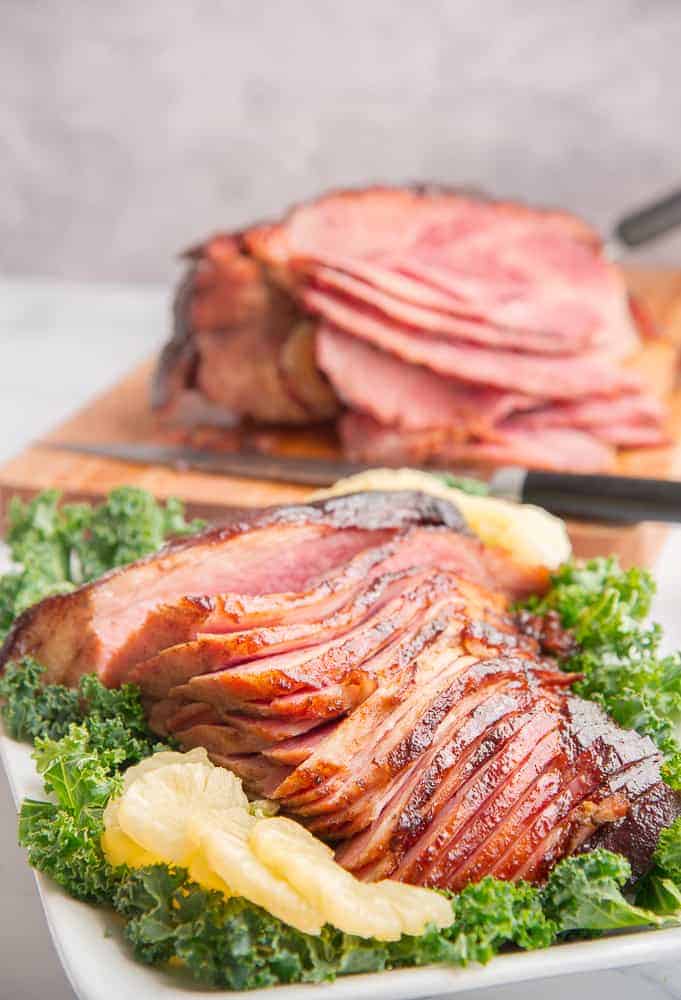
What Is Ham?
A ham roast is a primal cut of meat from the hind (or back) leg of a pig. This cut, when straight off a fresh pig, is a fresh ham. You can roast this meat as is, but the cut is smoked or cured more often than not.
Depending on what’s available in your grocer’s meat section, you might have a variety of cures to choose from. In short, curing is a process of preserving meat past its “sell-by date.” A fresh ham is only good for a certain length of time. The curing process extends that life by anywhere from a few days to years. The most popular cures here in the States are wet brines and smoking.
The ham we’re using for this recipe shouldn’t be confused with the cold cuts or steaks sold in the deli section. This recipe also isn’t interchangeable with a fresh ham, which would take many more hours to cook.
What Cut of Meat Do I Buy?
The most important thing to remember when looking for the best ham for this recipe is avoiding are any that are already flavored. Flavoring (other than smoke flavor) will compete with the brown sugar glaze.
Usually, if you see “water added” on your meat label, it means that it’s been wet cured. Some brine has been injected into the meat, often with nitrates, to preserve it. The nitrates give the meat its pretty pink color. In addition to the brine, your package may say “Hardwood Smoked.” That label means that the meat hanged over smoking hardwood to give it some flavor and cure it (bacon is made this way). If you have meat in a plastic package from the refrigerated meat case, it’s wet cured and perishable. That’s the cut you want for this recipe. Dry brined or smoked (in the cloth wrapping on the shelf) won’t work for this specific recipe.
Avoid spiral cut ham as well. You don’t want a sliced ham because the more cuts in the meat before we start doing our thing, the more it will dry out.
How Much Meat Do I Need Per Person?
A good ham ratio to remember when shopping for your holiday dinner is 8 ounces pre-cooked weight per person. Remember that food loses volume when cooked, so you’re going to end up with less weight after cooking it. So, if you are expecting 6 guests, buy a ham that weighs 3 pounds. The reality is that there are very few hams that weigh less than 5 pounds. Those that are won’t take as long to reheat, but they also won’t leave you with leftovers.
Half-hams usually range in size from 7-12 pounds. Any ham that is 14 pounds or heavier is a whole ham.
A 10-pound ham will give you plenty of leftovers for 2 days of dinners, a quiche or two, and maybe a couple of omelets.
Do I Need a Fully Cooked or Uncooked Ham?
Buy a fully cooked ham for this recipe. It will say so on the packaging. A fully-cooked ham only requires warming up in the oven. Because of the size, “warming” a 10, or even 8-pound cut of meat takes a couple of hours.
Definitely avoid a fresh ham or one that is only cured but not cooked. Both will add a considerable amount of time to this recipe.
What Other Ingredients Are In This Recipe?
Besides a fully-cooked ham, the rub consists of Dijon mustard and light brown sugar (or dark if that’s all you have), ground cloves, cinnamon, allspice, ginger, nutmeg, cayenne pepper, kosher salt, and garlic powder. If you’re not a fan of spice, you can replace the cayenne with black pepper.
You need a large roasting pan to cook the ham in. The brown sugar and pineapple glaze you will make in a saucepan.
Before you begin anything, lower the rack in your oven to the lower third section of the oven. This will keep the meat from being too close to the heating element.
How Do I Make the Brown Sugar Mustard Glaze?
Whisk the light brown (or dark brown) sugar together with all of the other spices in a small bowl.
As with the brown sugar, the mustard is swappable. Instead of using dijon mustard, you can use prepared yellow mustard, spicy brown mustard, coarse, grainy mustards, or honey mustard. Each will give the ham its own unique flavor.
Add the mustard to a separate small mixing bowl and stir in 1/2 cup of the spiced brown sugar. The remaining brown sugar mix will go into making pineapple glaze later. Combine the mustard and sugar until it resembles a thick paste. If it’s crumbly, pour in a small amount of the pineapple juice. It should be the consistency of ketchup or mustard.
Pat the outside of the ham dry with paper towels after unwrapping it. Because the mustard paste likes to slide off of wet surfaces, drying the exterior helps it stick. Also, to make clean-up easier, I spray my sides and bottom of the pan, as well as the roasting rack with non-stick cooking spray before putting the meat on it.
Once that’s done, place the ham in the prepared roasting pan.
Can I Swap the Pineapple Juice with Some Other Juice?
You can replace the sweet pineapple juice in this recipe with another juice you prefer. It ceases to be a “Spiced Brown Sugar Pineapple-Glazed,” but if you choose the right juice, it’ll still taste great.
Complementary juices are:
- peach nectar
- apple juice
- orange juice
- cranberry juice
- beer (not a juice, but oh well)
You just need a liquid that provides flavor. Pour half of the pineapple juice into the bottom of the roasting pan.
The bromelain enzyme in pineapples is a natural tenderizer, which is why pineapple is in so many meat marinades. But, here, we’re using it to keep the meat moist and to infuse flavor. Once we cover the pan with tin foil, the pineapple juice will heat up and begin steaming up and into the meat. Again, this is why we want to use a liquid with flavor in it.
What’s the Best Way to Roast the Ham?
Begin roasting the ham with it on its cushion, so the fat from the top drips down into the meat. You tend to lose more of the juices if you start it flat side down, especially since we’re elevating it on the rack. Later, you will flip it to coat the outside with the glaze, but we’ll cross that bridge when we come to it.
For now, use a spatula or your hand to coat the exterior of the ham with the mustard-brown sugar paste. Lift up the meat to get that paste underneath it, too. Slather the cut part of the meat (where you can see the interior) in the paste, too. There’s no such thing as putting too much, so be sure to use it all.
Once you spread the paste on the ham, cover the pan tightly in heavy-duty aluminum foil. Sometimes, I spray the part of the foil that will touch the meat with non-stick cooking spray. This keeps the foil from sticking to the collagen-filled skin and ripping it off when I remove the foil later.
How Long Do I Roast the Ham?
Roast your ham in a 325°F (162°C). The length of time to roast your ham depends on how big it is. Remember, that you’re just warming it.
Heat the ham 15-20 minutes per pound:
- 10-pounds: 2 1/2-3 hours
- 12-pounds: 3-4 hours
- 14-pounds: 3 1/2-4 1/2 hours
- 15-pounds: 3 3/4-5 hours
Depending on how particular you are about the “doneness” of your meat, you can heat it for 20 minutes per pound. I don’t like dry meat, so I only heat mine for 15 minutes per pound. Since there’s an additional cooking time of 30-45 minutes of caramelizing after adding the pineapple glaze, I recommend the 15 minutes per pound unless you really like well done meat.
How Do I Make the Spiced Brown Sugar Pineapple Glaze?
To make the spiced brown sugar pineapple glaze for the ham, add the remaining spiced brown sugar, the remaining pineapple juice, and the vanilla extract to a saucepan. Turn the stove to medium heat and use a whisk to combine them, stirring to dissolve the sugar. Bring the mixture up to a boil.
Once the mixture starts to boil, reduce the temperature to low and allow the glaze to simmer for 10 minutes. The glaze will thicken and reduce, becoming more concentrated in flavor. The line in the pot where the sauce began is an indicator of how much it’s reducing. You can turn the stove off and allow the glaze to chill on the stovetop when the level of glaze drops halfway from the starting line.
You can make ham glaze a day or two in advance and store it in a covered jar in the fridge. Reheat the glaze as needed in the microwave to make it easier to brush on the ham.
You can also freeze the ham glaze after making it and allowing it to cool. Just transfer it to a freezer storage bag and freeze it for 2 months. Thaw it in the fridge and reheat it if necessary before brushing it on the ham.
How Often Do I Baste the Ham?
Remove the roasting pan from the oven once the heating time is up. Remove the foil covering, but don’t throw the foil away. Increase the oven temperature to 425°F (218°C).
If you can, carefully flip the meat so the cut side is facing down so that the exterior is exposed. This allows you to brush the glaze all over the ham and results in all of the ham slices being glazed.
Brush a third of the glaze onto the surface of the ham using a basting brush. I brush my roast 3 times (using a 1/3 of the glaze each time) because I like a crisp, caramelized exterior. You can do the same or only brush it twice with 1/2 of the glaze.
What Is the Internal Temperature of Fully Cooked Ham?
Return the ham to the oven to caramelize the glaze for 15 minutes. Remove the pan, brush it with another 1/3 or 1/2 of the glaze, and pop it back into the oven for another 15 minutes. If you did the 1/3 glaze, brush on the remaining glaze, then, once the ham is properly caramelized and glazed, remove the pan from the oven.
A safe internal temperature for ham is 145°F (62°F), which you can measure by inserting an instant-read thermometer into the thickest part of the roast. The old-school temp was 165°F (73°C), but a range between the two is fine. The ham, when at its juiciest, has a blush-pink color.
A great way to ensure your ham is safe for your dinner is to use an internal meat thermometer to monitor it.
How Do You Carve a Ham?
The biggest mistake people make when roasting or cooking meats is cutting into it too fast. Before cutting your glazed ham, allow it to rest at room temperature for at least 20 minutes. Use the foil you saved earlier to make a tent over the ham. The foil retains the heat, while the tent shape allows steam to escape, so the caramelized exterior doesn’t get soft.
Use a thin, long, sharp knife to carve your glazed ham. You can also use an electric carving knife to carve the ham if you have one. Place a damp paper towel under your cutting board, so it doesn’t move while you carve the meat.
Transfer the ham to the cutting board after resting it. Situate the meat so that the flattest part of it is on the bottom. This gives you a sturdy base on which to work. Position the blade of your knife so that you’re cutting parallel to the bone. Listen, bones are wonky, so you never know what it’s doing inside that ham. Just do your best to cut into the meat along the bone. Remove the blade from the ham and position it so that you’re cutting perpendicular to (or down towards) the bone. Once you hit the cut you made earlier, you can remove this big ol’ chunk of meat.
Set it to the side and remove the other half of the meat that’s still attached to the bone. Don’t discard the ham bone! You can use it to add flavor to your soups and stews later. Freeze the ham bone in a freezer bag for up to a year.
Use the carving knife to thinly slice the chunks of (now) boneless ham meat.
What Recipes Can I Serve This Ham With?
Arrange your glazed ham slices on a serving platter with or without sliced pineapple. It helps to let your diners know what’s in the glaze.
Serve the glazed ham with 5-Cheese Macaroni and Cheese and Country Style Slow-Cooker Collard Greens for a traditional Soul Food Supper. A typical Puerto Rican ham dinner includes Arroz con Gandules and Puerto Rican Potato Salad. Ham is one of those meats that go well with most side dishes. And what’s great is that it tastes great hot, room temperature, or cold.
How Do I Store Leftovers?
Transfer any leftover glazed ham to an airtight container and store it in the refrigerator for 3-4 days.
Reheat the slices you want to serve in the microwave or in a shallow skillet with a little bit of water. You can also sear it quickly in a non-stick pan to reheat it.
Can I Freeze Leftovers?
You can freeze leftover ham for 2 to 3 months. Allow it to cool completely, then transfer the ham slices to freezer storage bags. Thaw the ham under refrigeration, then reheat as needed and serve.
What Are Some Recipes That I Can Use Leftovers In?
You can use leftover ham to make sandwiches, soups, or casseroles. Here some of my favorite recipes to use leftover meat in:
Quiche Lorraine (replace the bacon with it)
This baked Ham with Spiced Brown Sugar Pineapple Glaze is an easy main dish to serve at your holiday table or for simple Sunday dinners. You’re going to love how easy this comes together to create the centerpiece for a delicious dinner. Be sure to pin this recipe to your meats board and let me know what you think of it in the comments below.
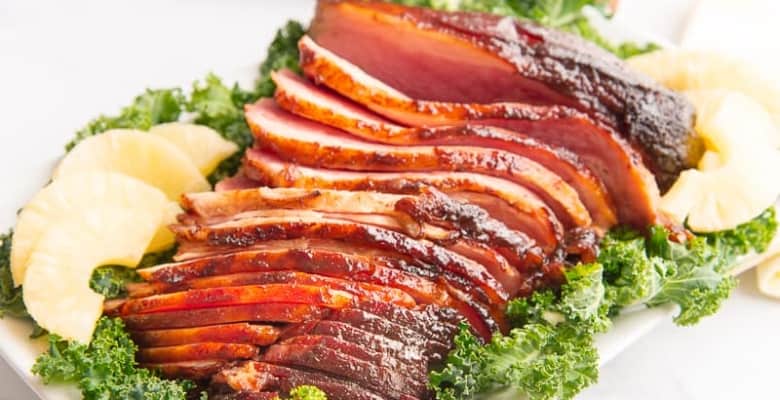
Ham with Spiced Brown Sugar Pineapple Glaze
at Sense & EdibilityEquipment
- roasting pan with rack
- internal meat thermometer
Ingredients
Spiced Brown Sugar
- 1 cup (220 grams) light brown sugar
- 1 tablespoon (6 grams) ground cinnamon
- 2 teaspoons (6 grams) kosher salt
- 1 1/2 teaspoons (4 grams) ground cloves
- 1 1/2 teaspoons (3 grams) ground ginger
- 1 teaspoon (3 grams) granulated garlic
- 1 teaspoon (2 grams) ground nutmeg
- 1 teaspoon (2 grams) cayenne pepper optional
- 1/2 teaspoon (1 gram) ground allspice optional
- 2 tablespoons (45 grams) dijon mustard
For the Ham
- 10-12 pound (4-5 kilos) fully cooked ham preferably bone-in (also called gammon, butt, shank, or whole ham)
- 1 1/2 cups (360 milliliters) pineapple juice
- 1 teaspoon vanilla extract optional
Instructions
- Lower the middle oven rack to the lower third section of the oven. This will keep the ham from being too close to the heating element.Preheat the oven to 325°F (162°C) and spray your roasting pan's rack with non-stick cooking spray. This will make cleanup easier.
Mix the Spiced Brown Sugar
- In a mixing bowl, whisk together the light brown sugar, cinnamon, kosher salt, cloves, ginger, garlic, nutmeg, cayenne pepper, and allspice until thoroughly combined. Add 1/2 cup of the brown sugar mixture to a bowl with the dijon mustard. Set aside the remaining spiced brown sugar. Stir the mustard and sugar until it resembles a thick paste. If it's crumbly, stir in a small amount of the pineapple juice. The paste will be the consistency of thick mustard.
Baste, Then Heat the Ham
- Unwrap and pat the exterior of the ham dry with paper towels. Set the ham on its cushion on the prepared rack that's been set inside of a roasting pan. Pour 3/4 cup of the pineapple juice into the bottom of the roasting pan.
- Use a spatula to coat the exterior of the ham with the mustard-brown sugar paste. Make sure you spread this mixture over the entire ham. Once you spread the paste on the ham, cover the pan tightly in heavy-duty aluminum foil.
- Place the covered ham in the oven and cook it according to the chart below in the notes section or for 15-20 minutes per pound.
Prepare the Spiced Brown Sugar Pineapple Glaze
- Fifteen minutes before the end of the ham's cooking time, begin the glaze. In a saucepot, whisk together the remaining spiced brown sugar and pineapple juice, as well as the vanilla extract.
- Turn the stove to medium and bring the mixture to a boil, stirring to dissolve the sugar. Once the mixture starts to boil, reduce the temperature to low and allow the glaze to simmer for 10 minutes, reducing the liquid in the pot by half.
- Once the glaze has reduced by half, turn the stove off and allow the glaze to cool down on the stovetop.
Caramelize the Ham
- Once the heating time is finished, remove the ham from the oven. Increase the oven temperature to 425°F (218°C).Remove the foil covering, but don't throw the foil away.
- If you can, carefully flip the ham so the cut side is facing down. Use a basting brush to brush 1/3-1/2 of the pineapple glaze onto the surface of the ham. Return the ham to the oven and allow the glaze to caramelize for 15 minutes.
- After 25 minutes, remove the pan from the oven and brush it with another 1/3-1/2 of the glaze, then return it to the oven for another 15 minutes. If you did the 1/3 glaze, brush a third time, return it to the oven, then, once the ham is properly caramelized and glazed, remove the pan from the oven.
- The internal temperature of the ham should be between 145°F (62°F)- 165°F (73°C). The ham should have a blush-pink color when sliced.But before cutting into it, grab the foil you saved and make a tent over the ham with it. Allow the meat to rest for no less than 20 minutes under this foil tent.
- After the meat has rested, transfer the ham to a cutting board. Situate the meat so that the flattest part of it is on the bottom. This gives you a sturdy base on which to work.Position the blade of your carving knife so that you're cutting parallel to the bone and cut into the meat along the bone.
- Remove the blade from the ham and position it so that you're cutting perpendicular to (or down towards) the bone. Once you hit the cut you made earlier, you can remove the chunk of meat. Remove the other half of the meat that's still attached to the bone. Put the ham bone into a freezer bag and freeze for later (up to a year).
- Use the carving knife to thinly slice the ham.Serve it straight from the cutting board or transfer it to a platter.
Notes
- Make sure your ham's label says "fully cooked". A fresh ham is not recommended for this recipe.
- Avoid flavored or spiral cut hams. Flavoring (other than smoke flavor) will compete with our made-from-scratch glaze. Spiral hams will dry out during the cooking process.
- Plan to have enough ham to serve 1/2-pound per person:
Half-hams usually range in size from 7-12 pounds. Any ham that is 14 pounds or heavier is a whole ham. A 10-pound ham is perfect for a family of four to have enough leftover ham for a couple of other meals/recipes. - Fashion a roasting rack out of aluminum foil if you don't have one: form a tube of heavy-duty foil into an oval shape and place it in the bottom of the pan. Set the ham on top of this foil.
If you don't want use a rack, just set the ham into the bottom of a roasting pan.
Swaps and Subs:
- Substitute the light brown sugar with dark brown
- Instead of using dijon mustard, use coarse grain mustard, honey mustard, prepared yellow mustard, or spicy brown mustard
- Replace the pineapple juice with peach nectar, apple juice, orange juice, cranberry juice, or beer.
Don't replace the pineapple juice with water.
Heat the ham 15-20 minutes per pound:
- 10-pounds: 2 1/2-3 hours
- 12-pounds: 3-4 hours
- 14-pounds: 3 1/2-4 1/2 hours
- 15-pounds: 3 3/4-5 hours
Storage and Freezer Instructions:
- Transfer any leftover ham to a food storage container and store them in the fridge for 3-4 days.
Reheat just the amount you want to serve in the microwave or in a shallow skillet with a little bit of water. You can also sear it quickly in a non-stick pan to reheat it. - If you have tons of leftover meat, cool it completely, then pack it into freezer storage bags. Freeze the meat for 2-3 months.
Thaw the frozen ham under refrigeration, then reheat it as needed and serve.

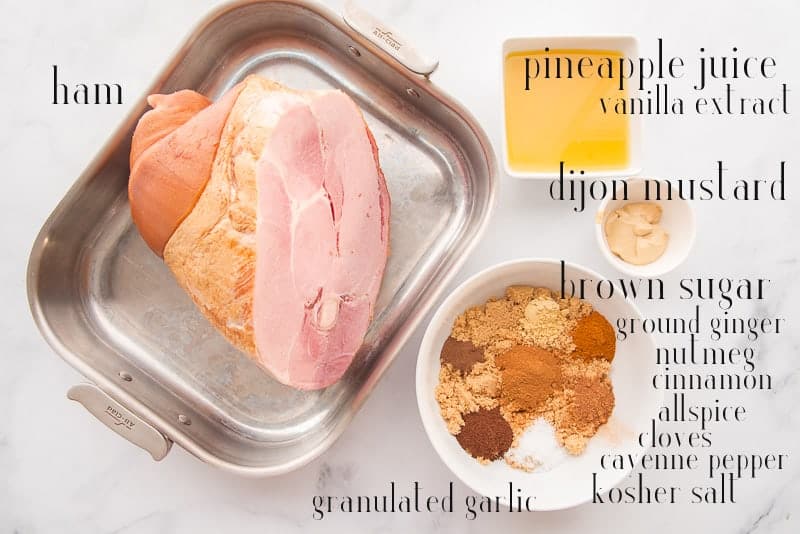
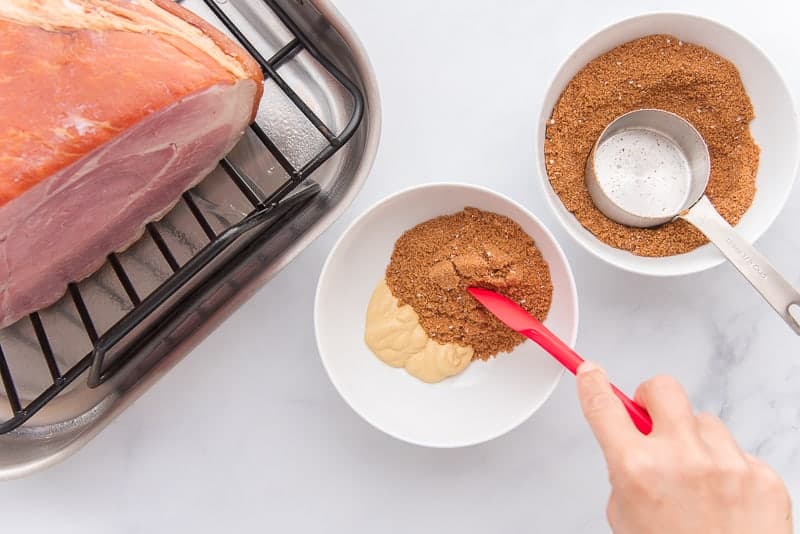
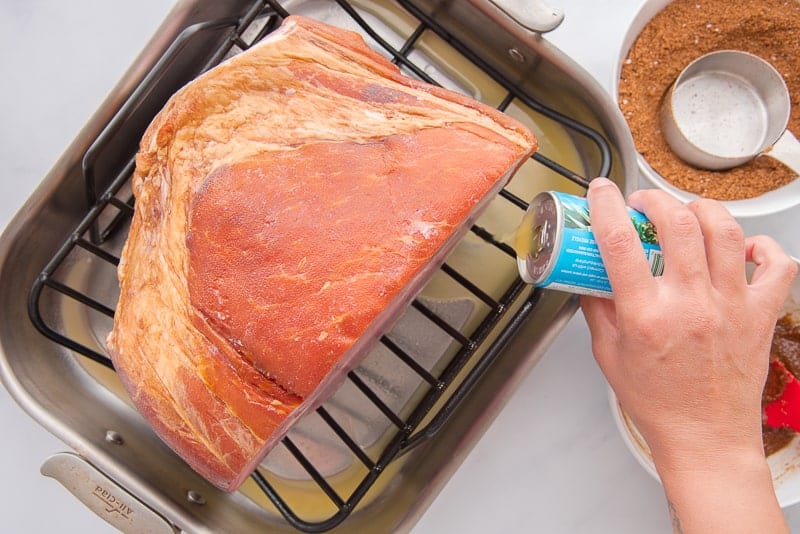
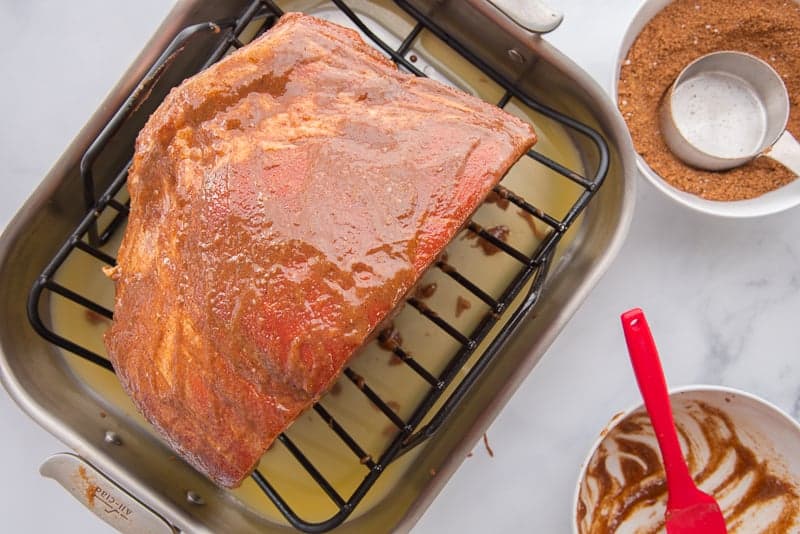
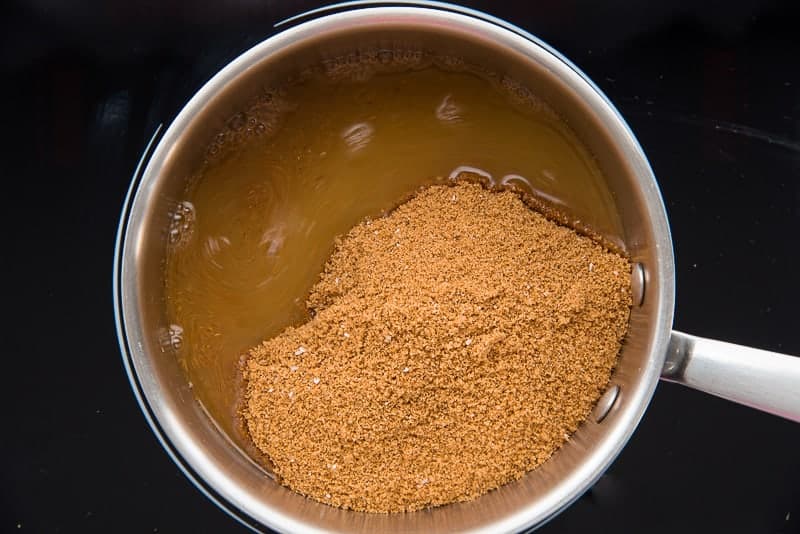
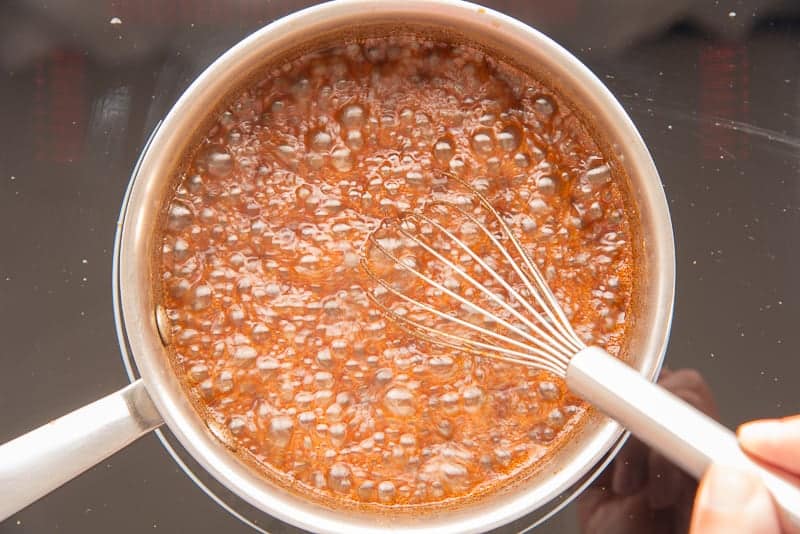
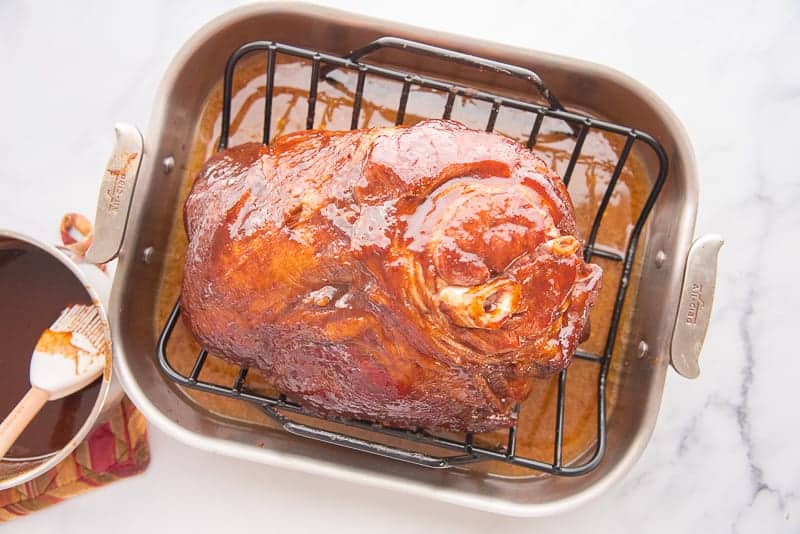
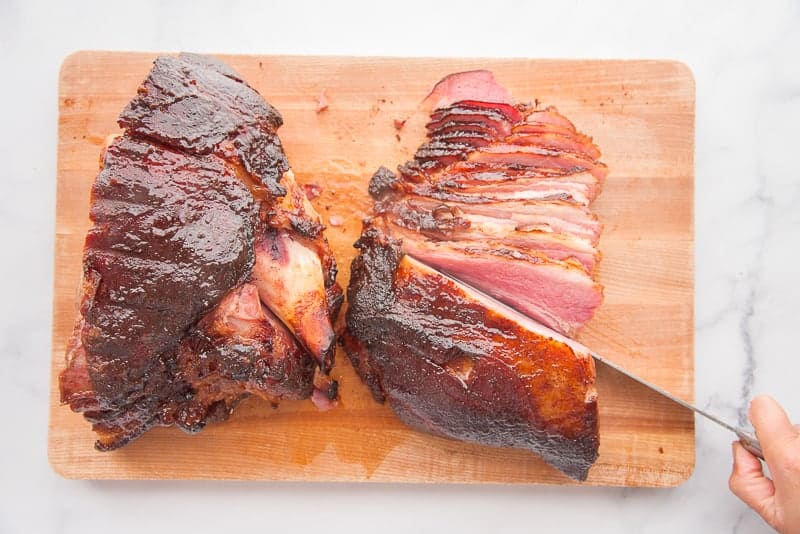
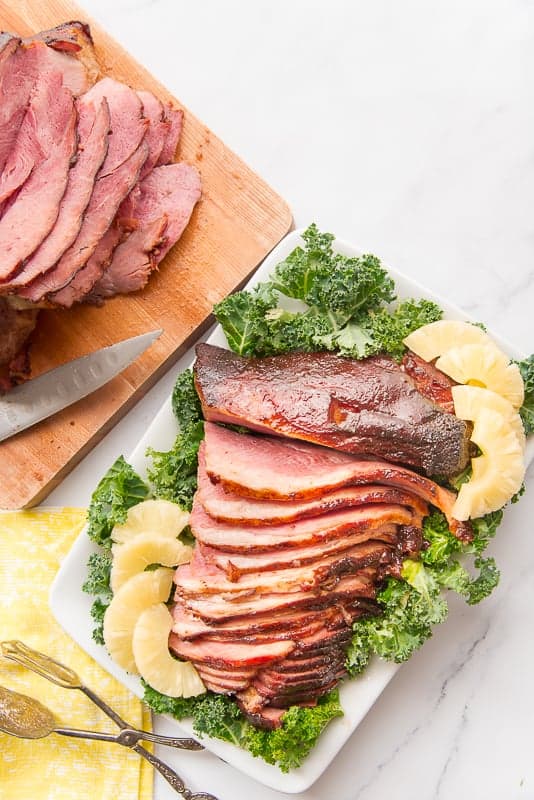
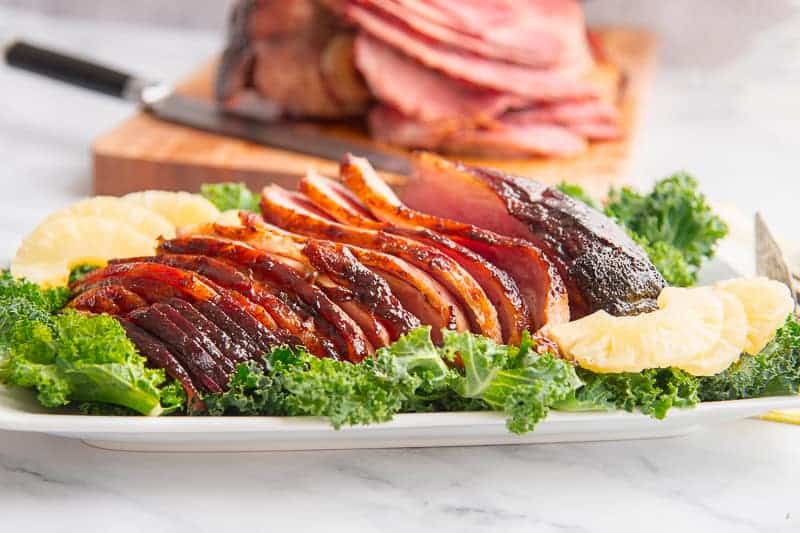
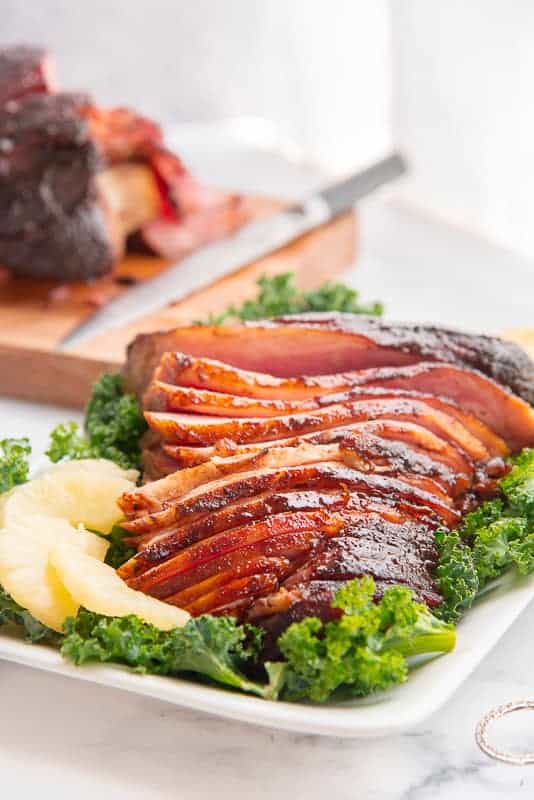
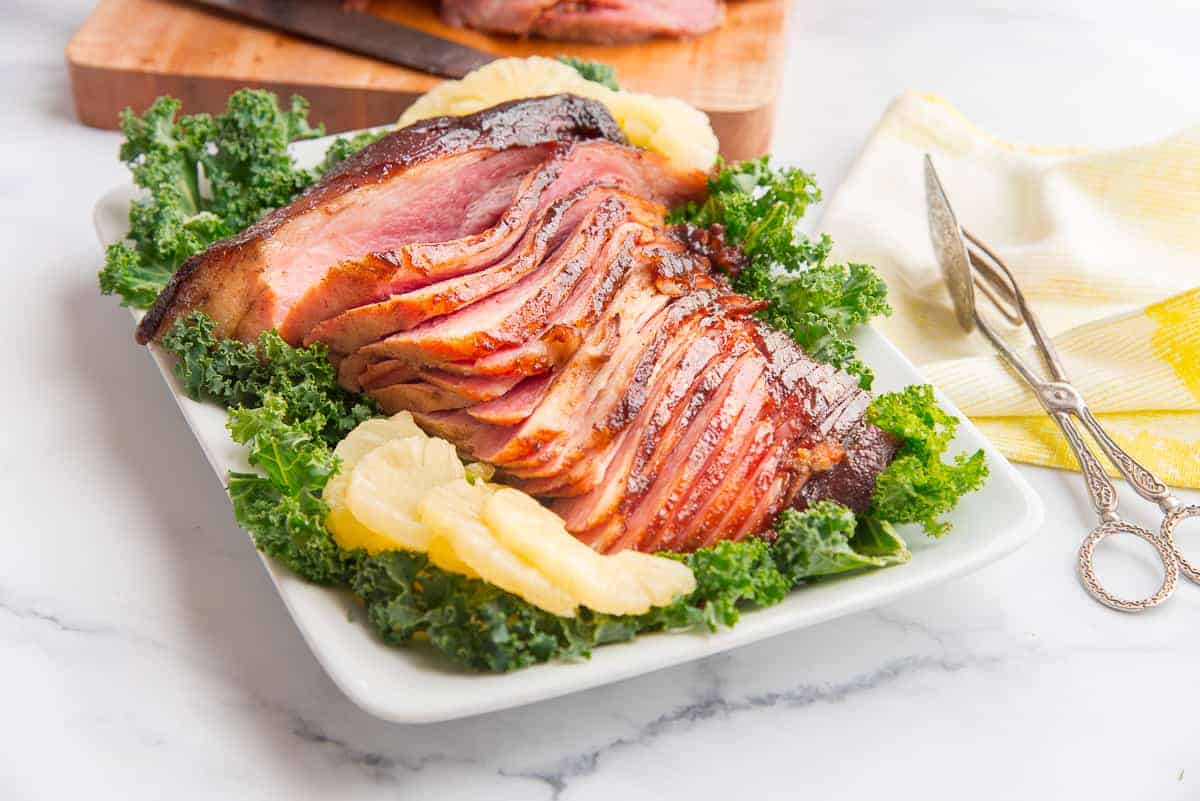



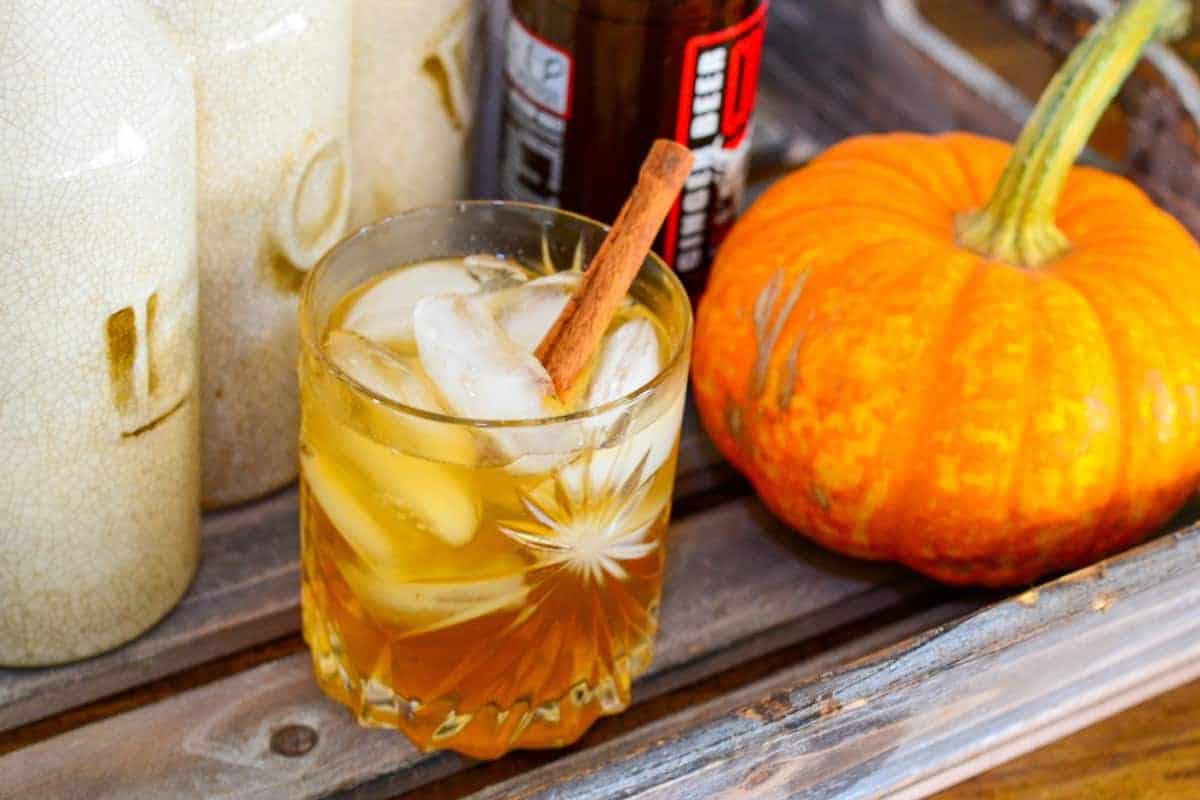
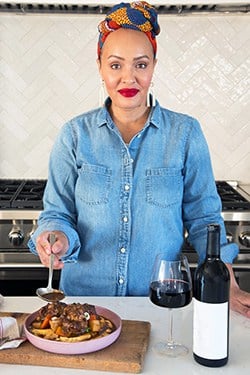
A must have for Easter! Your recipes was so simple to follow and that ham came out DELICIOUS!
Thank you, Eden!
Such a classic ham recipe and love the flavors. Thanks for the detailed recipe and for the whole process. The sweet and spice levels were just perfect and looking forward to trying a few of the recipes that you have suggested with the leftovers.
I’m glad you liked it Sandhya. You’ll love using the ham in leftovers as well!
HAHA I’m so with you on the pineapple ring/cherry centers when it comes to Easter Ham! Loved the spice level of this so much! Definitely a keeper!
I’m glad you liked it, Lori.